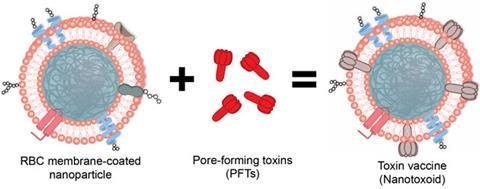
Researchers in the US have developed a new way of vaccinating against bacterial toxins by caging them in hybrid nanoparticles. The approach does not require physically or chemically modifying the toxin to make it safe before giving it to the patient. This gives the vaccine an important advantage over conventional ones, as denaturing the toxin can change key structural features that the immune system uses to recognise future attacks.
A team led by Liangfang Zhang at the University of California, San Diego, created the new vaccine by coating nanoparticles of the polymer PFGA with the membrane from red blood cells. They then exposed these membrane-encased particles to a model toxin, a-haemolysin from the bacterium Staphylococcus aureus. Toxin proteins become embedded and trapped within the membrane. Tests on mice showed that the toxin–nanoparticle conjugate is not harmful, but does elicit an immune response and protected the mice from future exposure to the toxin.
‘Once the toxin has inserted itself into the nanoparticle’s membrane, it is in essence “locked in” and will no longer interact with live cell membranes,’ says Zhang. Once inside the mice, the particles are engulfed by specialised immune cells. As the hybrid nanoparticles are digested, these cells process the toxin and then display pieces of it to allow the immune system to memorise this encounter so it can fight off future infections.
Tests showed the vaccine to be more efficient than conventional approaches using denatured toxin, says Zhang. Similar pore-forming toxins from other bacteria should also be amenable to delivery by membrane-coated nanoparticles, Zhang suggests.
Experts in the field are impressed by the study, but point to potential drawbacks. James Moon of the University of Michigan in the US says: ‘This is a promising approach to enhance immunogenicity and efficacy of bacterial antitoxin vaccines while minimising the potential safety issues associated with virulence of toxoids.’ However, he adds: ‘It remains to be seen whether this nanoparticle vaccine can safely elicit antitoxin immune responses without generating autoimmunity to red blood cells, especially when they are formulated with vaccine adjuvants in future clinical trials.’
‘My feeling is that the FDA [US Food and Drug Administration] would be pretty reluctant to license a vaccine containing an unaltered toxin for human use,’ says Anthony Gregory of the University of Exeter in the UK. ‘Nonetheless, this is an interesting article and I think it says more about nanoparticles as vaccine delivery systems than it does about the actual vaccine they are testing.’






No comments yet